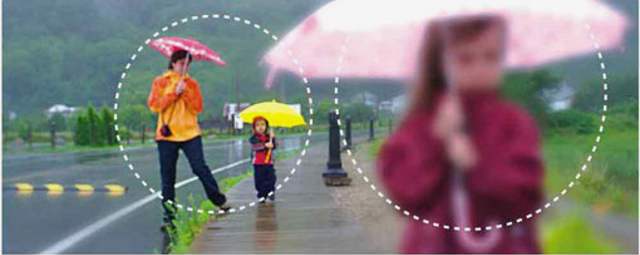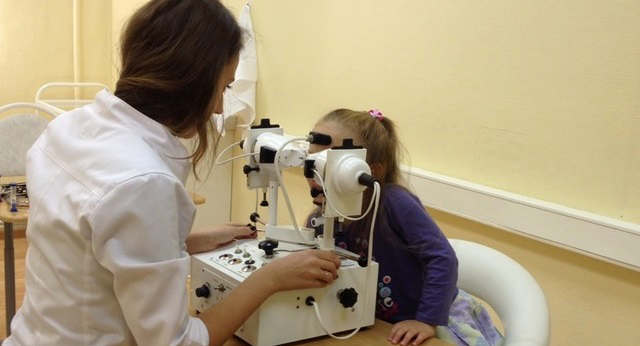DEPARTMENT
HYPEROPIA
Hyperopia, or hypermetropia, is one of the three main variants of refractive error (refraction and focusing of light) in the optic system of the eye. In contrast to myopia, when the focal point is shifted forward from the retina, or from astigmatism, in which the visual system is defocused along several meridians, hyperopia means a shift of the focal point along the main optical axis beyond the retina – there is a kind of “flight” of the point of focus. According to the laws of optics, this leads to the inability of a clear and sharp visual perception of closely located objects – with relative preservation of vision in the distance. Typically, this condition is accompanied by a number of additional symptoms: rapid eye fatigue, headaches, feelings of overstrain or burning in the eyeballs.

Causes of hyperopia
Like myopia (nearsightedness), hyperopia is caused by a violation of the optic-geometric parameters and proportions of the eyeball: either the refractive capacity of the cornea and / or the lens is insufficient, or the antero-posterior axis is too short – the eye is “flattened” horizontally and “extended” vertically . In either case, the focal point is behind the retina. There is also a combined variant, when insufficient refraction is combined with a shortening of the horizontal (longitudinal) axis.
Transient, the so-called. Physiological far-sightedness is observed in newborns and is considered normal if in the neonatal period does not exceed the degree of 4 diopters. If there is congenital hypermetropia of high or very high degree, such an anomaly is almost never isolated and is accompanied by other defects in the visual system (pathology of the vessels and optic nerve disk, cataract, aniridia, tendency to increase intraocular pressure), various anatomical development defects, congenital neurological pathology.
Normally, the size of the eyeball gradually increases with the general growth and development of the child’s body, and the anterior-posterior axis of the eye reaches its optimal, natural length of 23-25 mm. In the first years of life infant hyperopia, thus, regresses to the normative degree. However, sometimes the “longitudinal” growth of the eyeball does not stop in time, and the focal point is closer to the retina – myopia is formed; in other cases, on the contrary, the anterior-posterior axis remains shortened, and the vision, respectively, is farsighted.
The causes of such “growth ailments” to date are not completely clear. However, the hypermetropic refractive defect in most people is compensated by reflex, excessive reduction of the ciliary muscle, which makes it possible to give the lens a more spherical shape (ie, more refractive than normal geometry of the eye) and thus provide a relatively clear perception of distant objects. To mature and elderly age from constant stress, the ciliary muscle “gets tired”, its elasticity and contractility decrease, and the accommodating system no longer holds the lens in the right shape. Approximately sixty years (this age varies widely) the natural aging of the eye tissues and structures leads to a variety of problems and a general impairment of vision – both near and far. This state of the visual system is called “presbyopia”, or senile hyperopia (from the considerations of political correctness it is often called age-related hypermetropia, or long-sightedness of the elderly). Satisfactory quality of life is most often restored in the simplest and most accessible way – optical correction, i.e. “Plus” points of this or that force.
If myopia is always an excess of the collective ability of eye optics, then far-sightedness is its drawback: the rays are refracted weaker and therefore concentrate further. Therefore, it is natural that with the complete exclusion of one of the refractive elements, the lens, hyperopia is unavoidable. Afakia, or the absence of the lens, can be a congenital anomaly or consequence of trauma, surgical intervention to remove cataracts, and the like. Visual acuity drops to 0.1 from the norm or even lower, which requires either powerful optical correction or implantation of the IOL (intraocular lens, i.e., an artificial lens).
Symptoms of hyperopia
In young, young, early adulthood, the actual far-sightedness can be asymptomatic: the state of the accommodating system allows to compensate for the optical weakness of some overstrain, without bringing a person a tangible discomfort. However, even with a preserved compensatory ability, and with a sufficiently clear vision close to it, hypermetropia, say, of an average degree, will be manifested by visual fatigue, soreness of the eyeballs, headaches of a certain localization (nose bridge, superciliary arches, forehead). Sometimes a person, especially in a state of fatigue, notes with surprise that it is more comfortable for him to read the text at arm’s length, because when the letter approaches, it sometimes blurs or merges, an annoying sense of lack of light (previously quite sufficient) appears.
Congenital hyperopia of a high degree requires overexertion of the child’s visual system; the oculomotor muscular system is constantly trying to reduce its eyes to the nose for a clear focus. The risk of fastening such a reflex is high and, as a consequence, the development of convergent (friendly) strabismus. In turn, this is fraught with amblyopia (“lazy eye syndrome”), a violation of binocularity, psychological trauma and many other negative consequences.
Because of frequent involuntary urge to friction of hypermetropic eyes, – just as the short-sighted people are screwed up, – infant and youthful hyperopia are often accompanied by all sorts of infections and inflammations. In mature and old age, as established, hyperopia promotes persistent increase in intraocular pressure and the development of other glaucomatous symptoms.
Classification of hyperopia
There are a number of approaches to the classification of hypermetropia – depending on the goals and objectives of this categorization. So, according to the optic-geometric criterion, axial (axial) anatomical farsightedness differs from the farsightedness of the refractive, related to the deficit refractive power; on the safety of the compensatory ability, latent (hidden) and explicit variants are singled out, and with age, the former is usually transformed into the second. According to the age criterion, hyperopia is divided into normal-physiological hypermetropia of newborns, pathological congenital hyperopia and presbyopia.
However, for practical purposes, the severity of hypermetropia is most often important. On this basis, three degrees are distinguished:
- weak (0-2 D);
- average (2-5 diopters);
- High (5 or more).
Treatment of hyperopia
To date, hyperopia does not belong to incurable diseases, which allow only softening of symptoms for unrecoverable reasons.
Along with the palliative conservative correction (glasses), a number of methods for radical elimination of hyperopia as such have been developed. The two main areas are ophthalmosurgery (keratoplasty, IOL implantation, etc.) and excimer laser correction (LASEK, LASIK, Femto LASIK, etc.). In any case, the treatment should be timely, and the choice of the method – based on a thorough and comprehensive study of the history, dynamics, current clinical picture.
In the absence of a pronounced, quality-reducing discomfort, while preserving the normative visual acuity in both eyes and the ability to binocular perception – interference is not shown.
In childhood, radical correction is also not made: limited to the prevention of further progression and the appointment of adequate glasses with regular ophthalmic control. Preschoolers with hypermetropia more than 3 Dpt. Glasses should be worn constantly, and clinical observation is designed to timely detect and prevent the development of strabismus and / or amblyopia; with favorable dynamics, optical correction can be canceled by the beginning of schooling.
For passive correction of hyperopia, not only glasses, but also contact lenses are used. Research and development continues all the time; In practice, new modern materials and lens models are introduced-in particular, the so-called. orthokeratological, or “night” lenses, which are worn only for the time of sleep and change the shape of the cornea relatively stably in such a way that sufficient refraction is provided for daytime (however, such lenses are capable of correcting hyperopia only up to 3 diopters). With hyperopia of a high degree, bifocals can be assigned, or two pairs of glasses – for sight in the distance and close.
Very effective, but unfortunately not yet fully appreciated method is hardware-simulator treatment (devices such as amblyobicor, synoptophor, vizotronic, computerized complexes), physiotherapeutic and reflexotherapeutic methods, vitamin therapy. When watching TV or working with a computer, the negative effect of stagnant eye strain is reduced by perforating glasses.

Laser correction is usually appointed from the age of 18, but the lower and upper (45 years) age limits are not absolute or rigid. If there are no more serious contraindications (diabetes mellitus, chronic inflammatory diseases of the visual system, pregnancy or lactation), laser correction becomes an effective and radical solution to the problem; the risk of complications or side effects is lower for a number of reasons than for any other type of intervention.
Ophthalmic surgical treatment of hypermetropia, including the age-related, usually involves the replacement of a functionally untenable lens with an intraocular lens with greater optical power (hyperartiphakia), but other techniques of operative correction are used, depending on the indications.
BOOK ONLINE
Address
Qemal Stafa Str, Apt 31, 3-rd C Floor
Near the General Prosecutor’s Office
klinika.uzllova@yahoo.com
info@eye.al
Phone
0682074039
04 22 52 306


